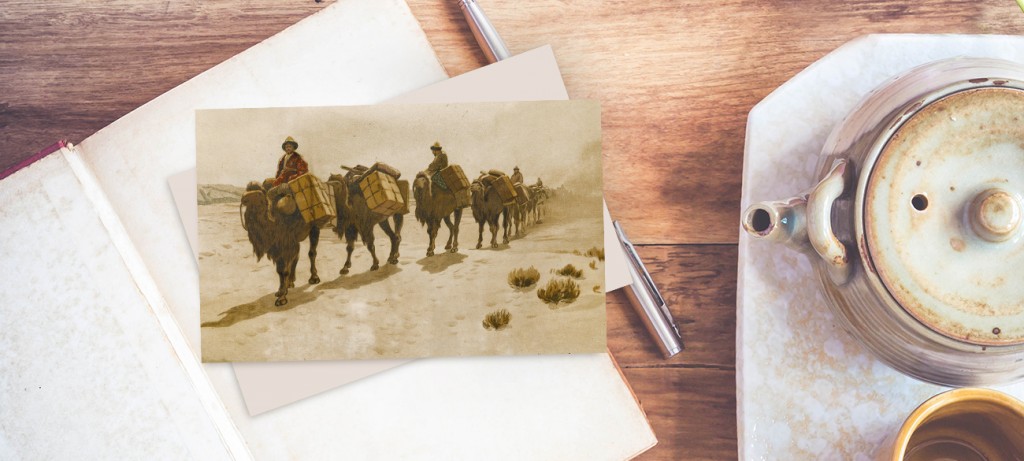Drinking something that tastes like “campfire, charcoal and chocolate” sounds like a punishment, but that’s not what a lover of Russian Caravan will tell you.
In fact, these are what make this particular tea ‘exceptionally delicious’.
Unlike an Earl Grey or the English Breakfast tea—blends that were an outcome of intent—the Russian Caravan was actually an accidental discovery; an unexpected occurring of one too many unfortunate events that should have rendered a tea bad, but ended up extolling its good virtues instead.
The tea originated in the ancient Sino-Russian trade route, established sometime in the late 1600s, over which large quantities of tea were exported from Imperial China to Tsarist Russia. Mile-long camel caravans loaded with tea traveled some 10,000 kilometers via Siberia for 16 long months. In Russia, this tea was bartered for fur. Now, there was a shorter route that curved around the southern borders of Odessa, but on this road the tea suffered from the moist air of the tropical sea. The Siberian path, on the other hand, preserved the integrity of the tea, thanks to the cold and dry climate that loomed over this route.
The caravans that traveled along these cold, snow-covered roads, would stop for a rest around campfires. Parked next to the fire, the teas too acquired some of the woody smoke, turning ever so slightly smoky each day. By the time this tea made it to Russia, it tasted quite smoky and rather strong. Fortunately, this suited the Russians; the strong, smoky tea resembled tobacco and firewood – both most commonly associated with giving warmth and comfort. Like the sight of crackling firewood on a winter’s day, this tea evoked a pleasant association, nearly as good as the real thing.
[bctt tweet=”Drinking something that tastes like “campfire, charcoal and chocolate” sounds like a punishment, but that’s not what a lover of Russian Caravan will tell you.”]
These recurring episodes (in the course of every caravan journey) were incident making. Not only did trans-continental trade flourish with the growing popularity of tea, but it also gave the world a whole new class of tea which may have, otherwise, been discounted as ‘ruined’ by the purists.
Suffice to say, the Russians were drinking the world’s first unofficial Lapsang Souchong tea—a black tea smoked over pine wood fire—but it wouldn’t be until much later that tea producers in China’s Qing Dynasty would create the Lapsang Souhcong (‘la’ = pine, ‘sang’ = wood and ‘souchong’ = the large-sized tea leaf), which was, once again, an outcome of accident than intent.
In trying to process the tea leaves faster than usual, fearing an impending attack in the tea-growing Wuyi Shan province, fresh leaves were quickly dried over smoked pine wood from the local forest. The result: a dark looking tea with a very smoky taste. When presented, rather nervously, to the Dutch tea traders, the tea-loving westerners couldn’t get enough of the baronial, smoky taste, some even willing to pay twice the value of the tea.
Over the years, Russian Caravan has developed into a blend. Besides the smoky Lapsang Souchong, the Keemun black tea has been used to achieve a richer body and smoothness along with an oolong tea or a Yunnan black tea for a woody roundness. Even so, the strong, smoky taste of the tea remains the highlight of the blend.
Fact: It is nearly impossible to drink this tea the proper Russian way, which is by first producing a strong tea concentrate, typically in a samovar, and then pouring it into individual cups before tempering the decoction with water. It’s a volatile drink, purely on its own, that can put you in a caffeine fit sooner than you can say the words, but nonetheless a fine tea with a rich Sino-Russian heritage.
PS: Recipe developer and founder of Living the Gourmet, Catherine, has created a Christmas menu of Lamb Shanks and Orzo with Karithopita, and found that our Russian caravan blend completes it perfectly. Find the recipes here.


1 Comment
Thanks for the detailed history it has added to my enjoyment of this new-found tea